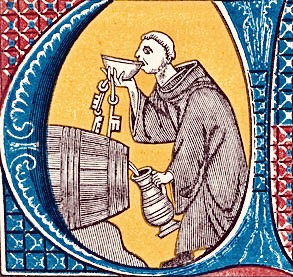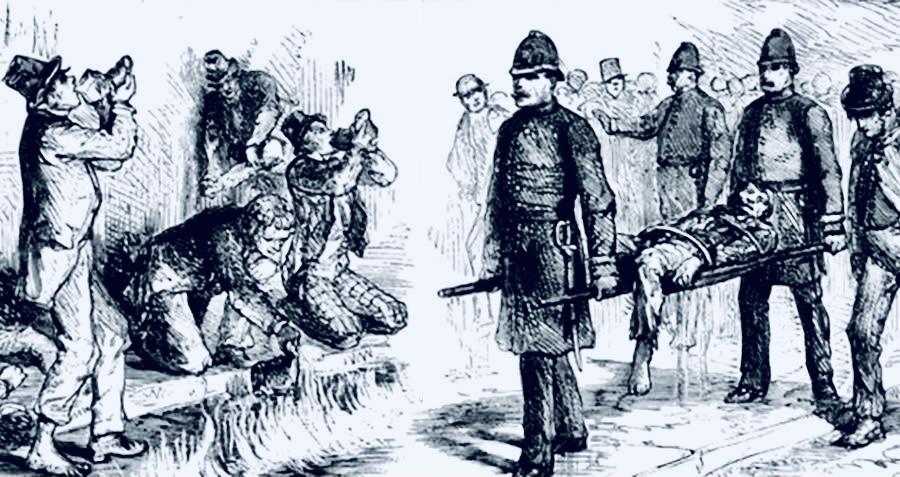
For centuries there has been an ever present debate over which is the best and which came first – Irish whiskey or Scottish whisky. Of course for us Irish there is no doubt whatsoever. As well as having the best whiskey, our whiskey heritage is hands down, one of the most chequered and interesting in the world. From superstitions to hauntings and graveyards to whiskey lava in the streets of Dublin – we have it all!
In the Beginning there was the Water of Life

Early Medieval Irish monks would distil alcohol in the monasteries and called it Uisce Beatha, which translates as the ‘water of life.’ Monks who travelled in Europe returned with the knowledge of distillation, obtained from the perfume makers of the continent. They then used the technique to make a distilled liquid that was flavoured with herbs and spices for drinking.
While the Scottish lay claim to the earliest documented mention of whisky in 1494, made by Friar John Cor, Ireland seems to have beaten them to it. In 1405, the Annals of Clonmacnoise reported the death of a local clan chief, Richard Magrannell, after supping on the water of life, his death preceding an internal fire into the pit of his stomach. The water of life became the water of death for this chief, there’s irony for you!
The arrival of the “e” in whiskey which separates it from its Scottish neighbours, was very much a late addition to the process and was added to mark clearly the difference between the two Celtic products.
The two spirits are produced in very different ways, and it is Ireland’s more refined distilling process that brought a Scotsman to our shores to distil one of Ireland’s most famous whiskies! We shall find out more about him shortly.
Kilbeggan – Ireland’s Oldest Distillery and the Ghost of a Monk

Whiskey had to be regulated, which means it could only be officially distilled by licence. In 1608, King James I granted a licence to Sir Thomas Phillips, who owned property and land in County Antrim -Bushmills to be precise! This does give Bushmills the claim to fame of being the oldest surviving grant of licence distillery anywhere in the world. They cannot however, lay claim to being the oldest working distillery, as they did not register to trade until the late eighteenth century.
The honour instead, goes to the Kilbeggan Distillery in County Westmeath, which is also home to the oldest working pot still in the world, at more than 250 years old. In 1757, Matthew McManus began the distillation of the whiskey with his family for almost 100 years before it passed to John Locke.
During his tenure, vital piece of equipment was damaged, threatening a halt to the production of Kilbeggan whiskey. John Locke put out the word in what could be described as an early ‘Go Fund Me’ move, which saw the people of the town of Kilbeggan make donations that enabled the broken part to be replaced and production to be continued.
This wasn’t the only time the townsfolk got together to protect the distillery – In 1878, a fire broke out and barrels of whiskey were set ablaze. The community once again came to the rescue, breaking down warehouse doors, going up against fire and smoke to rescue the ageing barrels of whiskey, rolling them down the street to safety. While many did go up in flame, the swift actions of the locals saved distillery once again!
Kilbeggan itself is haunted by at least two former residents. The first is the apparition of a monk, believed to be a part of the Cistercian order that had an Abbey founded very close to the distillery, dissolved in the mid 16th century. Murmuring, whispering and unexplained noises are also rife throughout the distillery.
The other is the spirit (pun intended!) of founder Matthew McManus, who is seen walking through the distillery, no doubt checking the process is running as smoothly as the whiskey itself.
The location has drawn much interest from the paranormal community. TV Medium Derek Acorah, claimed to have been overwhelmed by ghosts during his visit to Kilbeggan, including a lady who was a part of the Locke family, the last owners of the distillery before its temporary closure. More recently, the US Destination Fear team paid a visit for their TV show on the Travel Channel.
The Scottish Freemason who created Irish Whiskey

To the dismay of many an Irishman, our fine Jameson whiskey was actually created by a Scotsman!
John Jameson was a lawyer from Alloa, Scotland who married into the famous Haig distillery family. On arrival in Dublin in 1774, he immediately started networking and joined the Freemason chapter Convivial 202 in the capital city. A few years later, ‘The Liberator,’ Daniel O’Connell would join his own Dublin Freemason’s chapter and become pivotal in the demise of the Irish whiskey industry.
In 1780, John Jameson obtained existing distillery premises on the legendary Bow Street site, already home to several distilleries and began the famous Jameson whiskey legacy. Four of his sons continued in the whiskey industry, with one continuing to run Bow Street and the others opening rival distilleries. One such son, Andrew, moved to County Wexford and while his own distillery didn’t achieve much, he went on to be the grandfather of Italian aristocrat and inventor of the radio, Guglielmo Marconi.
An American Slavery Abolitionist, An Emancipator and a Priest Did Not Walk into a Bar

In the 1830s, a priest called Father Theobald Mathew started the Cork Total Abstinence Society. Eager to spread the message of joining the Temperance Movement, he caught the eye of solicitor and politician, Daniel O’Connell, who took the pledge and heightened awareness and status of the movement. O’Connell was invited as a guest speaker in Cork, with his new friend, black slave and advocate of the abolition of slavery, Frederick Douglass. Inspired by Father Mathew, Douglass also took the pledge and befriended the priest.
Frederick had already whipped up a frenzy travelling and speaking around Ireland so once again the strength of Father Theobald Mathew’s cause was at an all time high. The friendship between the two men was short-lived however, as Father Mathew visited America, only to slight Douglass by refusing to return the favour at an abolitionist rally.
The damage was done regardless and the demise of the Irish whiskey industry had begun. A solicitor had raised the bar for Irish whiskey distilling and another solicitor brought it down. The Temperance Movement peak was swiftly followed by the Irish Great Hunger – no grain meant no whiskey. Following on there was an ongoing battle for independence in Ireland, harsh tax levies, two world wars and the introduction of Prohibition and The Great Depression, plunging the Irish whiskey industry into a decline of epic proportions.
The Liberties and the Golden Triangle

The Liberties area of Dublin dates back to the twelfth century and is so named as it was split into local areas that were self-governed, while remaining under the unity of the city of Dublin.
It was notorious for being a place of destitution and crime, although over time it became a thriving weaving district. That is not to say it didn’t remain a dangerous place to be after dark – in fact the area was terrorised in the eighteenth century by a night prowling demonic pig, attacking women long before Jack the Ripper!
Nevertheless, in the heart of The Liberties was an area known as ‘The Golden Triangle,’ a name to be synonymous with the whiskey distilling giants of nineteenth century Dublin. Over a radius of just a mile, George Roe and Company, William Jameson and Company, John Power and Son and John Jameson and Son were the big names along with Guinness, however at one point there were some 40 distilleries in the area!
Pearse Lyons Distillery – Gothic Church, Medieval Graveyard and Superstition

One of the newest arrivals to the vicinity is the Pearse Lyons distillery, opened in 2017. Pearse Lyons and his wife Deidre decided they would return to their Irish roots and open a distillery in deconsecrated Saint James’ Church in the heart of The Golden Triangle. Having spent many years in Kentucky, it was time to bring some of that bourbon magic back to Dublin.
The Church site dates back to the thirteenth century, quantified by the adjoining graveyard which visitors to the distillery will discover. Painstakingly restored by architect Deirdre, the dilapidated Gothic structure now holds a magnificent glass spire based on the original, as well as a number of stained glass windows reflecting the distilling industry and paying homage to the area’s connection to the Camino de Santiago pilgrimage.

In fact nearby Saint James’ Gate, home to Guinness, contained a shrine and was a stop off for pilgrims since the Middle Ages. This is not the only connection between Pearse Lyons and Guinness – Mayor of Dublin Sir Mark Rainsford, died in 1709 and was buried in the graveyard attached to the distillery, but not before he sold his brewery to a certain Arthur Guinness!
During the ancient Fair of Saint James, families would spend time cleaning and restoring graves, before creating wreaths and decorations from nothing but white paper to cover the cemetery. Across from Saint James’ Church was a Holy Well and during this time locals would throw water left and right, back and forth, before drinking from the well, as a protection before they entered the fair, which continued until the early nineteenth century.
After this time, a fountain in the form of an obelisk was established over the Holy Well and funeral processions would stop as the coffin was paraded around the fountain three times before being carried into the graveyard to protect the departed soul from evil spirits!
The Fatal Whiskey Fire of Dublin
On 18th June 1875, The Liberties went up in flames.

A bonded warehouse containing some 5000 casks and Malone’s malthouse were the starting points for the fire, which claimed the lives of thirteen Dubliners, but not in the way that you might think!
The high proof spirit casks began to explode and roll out into the streets, creating a river of fast moving whiskey lava, cascading through the Golden Triangle. The poor of the neighbourhood grabbed any vessel they could find, from cooking pots to their own boots, scooping up as much of the water of life as they could. Pigs, sheep and chickens, kept in the city hovels and alleys, were terrified of the noise and flames. They stampeded across the streets for safety, knocking bystanders out of the way, adding to the chaotic scene.
Unfortunately for the greedy drinkers, the alcohol was not ready for consumption and alcohol poisoning took hold, with the thirteen men falling into comas and dying. Not one death was recorded due to burns or smoke inhalation.

As a result of this catastrophe, distillers and brewers were no longer allowed to store casks and barrels for any long period of time, a regulation that continues to this day, so Dublin distillers store their casks out of the city – Guinness however, are the exception, as they never hold onto a barrel of the black stuff long enough for it to become an issue!
So the next time you look into your whiskey glass filled with Ireland’s golden nectar, look a bit harder, as there is far more in it than just the Water of Life!
Sláinte!


